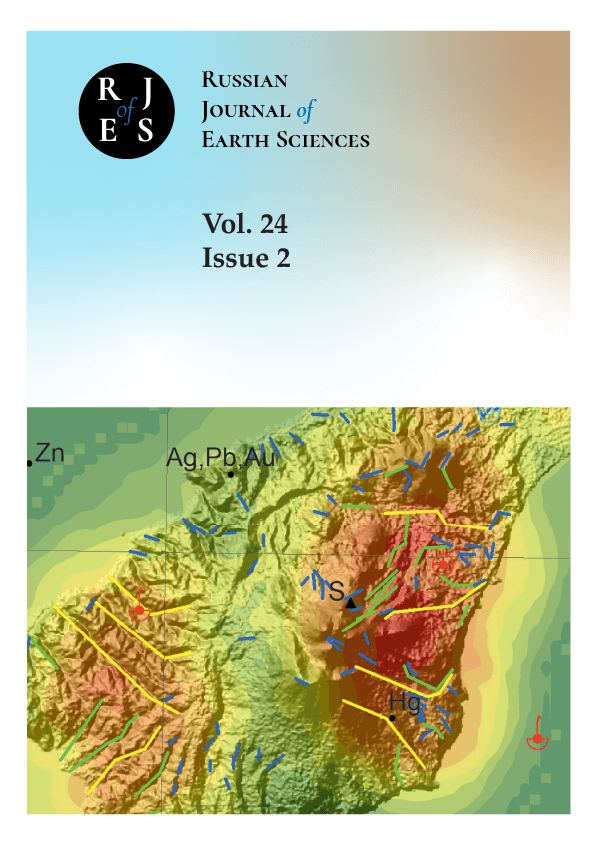from 01.01.1983 until now
Moscow, Moscow, Russian Federation
VAK Russia 1.6
UDC 53
UDC 55
UDC 550.34
UDC 550.383
CSCSTI 29.00
CSCSTI 37.00
CSCSTI 37.01
CSCSTI 37.15
CSCSTI 37.25
CSCSTI 37.31
CSCSTI 38.01
CSCSTI 36.00
CSCSTI 38.00
CSCSTI 39.00
CSCSTI 52.00
Russian Classification of Professions by Education 05.00.00
Russian Library and Bibliographic Classification 26
Russian Trade and Bibliographic Classification 5
Russian Trade and Bibliographic Classification 63
BISAC SCI019000 Earth Sciences / General
BISAC SCI SCIENCE
The earthquake of January 1, 2024 with the epicenter at Noto Peninsula of Ishikawa Prefecture, Japan, and the moment magnitude Mw = 7.5 obviously represents an intermediate case between weaker earthquakes with relatively small sources, like the 1995 Kobe and 2000 Tottori earthquakes (Mw ∼ 6.7–6.8), showing nonlinear soil response and soil softening (reduction of shear moduli) and stronger earthquakes, like the 2003 Tokachi-Oki and Tohoku earthquakes (Mw ∼ 8.3–9.0) with extended sources and source directivity effects, accompanied by soil hardening and generation of high peak ground accelerations (PGA) > 1g. In this research, based on KiK-net vertical array records (11 sites), models of soil behavior in the near-fault zones of the 2024 Noto earthquake are constructed, i.e. vertical distributions of stresses and strains in soil layers changing with time during strong motion, which showed nonlinear soil response and reduction of shear moduli in the near-fault zones. At the same time, the waveforms of acceleration time histories indicate the effects of source directivity, when seismic waves, radiated by the crack tip propagated along a rather long section of the fault plane, arrived to remote sites almost simultaneously, overlap, harden subsurface soils and generate high accelerations on the surface, PGA ∼ 2828 Gal at remote ISK006 station.
2024 Noto earthquake, directivity effects, abnormally high PGA, nonlinear soil behavior
1. Abrahamson, N. A. (2000), Effects of rupture directivity on probabilistic seismic hazard analysis, in Proceedings of the EERI 6th Seismic Zonation Workshop, EERI, Palm Springs (California).
2. Archuleta, R. J., and S. H. Hartzell (1981), Effects of fault finiteness on near-source ground motion, Bulletin of the Seismological Society of America, 71(4), 939–957, https://doi.org/10.1785/BSSA0710040939.
3. Fujii, Yu., and K. Satake (2024), Slip distribution of the 2024 Noto Peninsula earthquake (MJMA 7.6) estimated from tsunami waveforms and GNSS data, Earth, Planets and Space, 76(1), https://doi.org/10.1186/s40623-024-01991-z.
4. Hardin, B. O., and V. P. Drnevich (1972), Shear Modulus and Damping in Soils: Design Equations and Curves, Journal of the Soil Mechanics and Foundations Division, 98(7), 667–692, https://doi.org/10.1061/JSFEAQ.0001760.
5. Ishikawa, Yu., and L. Bai (2024), The 2024 Mj7.6 Noto Peninsula, Japan earthquake caused by the fluid flow in the crust, Earthquake Research Advances, p. 100292, https://doi.org/10.1016/j.eqrea.2024.100292.
6. Joyner, W. B., and T. F. Chen (1975), Calculation of nonlinear ground response in earthquakes, Bulletin of the Seismological Society of America, 65, 1315–1336, https://doi.org/10.1785/BSSA0650051315.
7. NIED (2024), Realtime hazard information, http://www.bosai.go.jp/e/index.html.
8. Pavlenko, O. V. (2008), Characteristics of Soil Response in Near-Fault Zones During the 1999 Chi-Chi, Taiwan, Earthquake, Pure and Applied Geophysics, 165(9–10), 1789–1812, https://doi.org/10.1007/s00024-008-0401-1.
9. Pavlenko, O. V. (2016), Atypical soil behavior during the 2011 Tohoku earthquake (Mw = 9), Journal of Seismology, 20(3), 803–826, https://doi.org/10.1007/s10950-016-9561-0.
10. Pavlenko, O. V. (2017), Possible Mechanisms for Generation of Anomalously High PGA During the 2011 Tohoku Earthquake, Pure and Applied Geophysics, 174(8), 2909–2924, https://doi.org/10.1007/s00024-017-1558-2.
11. Pavlenko, O. V. (2022), Influence of source directivity and site effects of 2003 Tokachi-oki earthquake on the generation of high PGA in the near-fault zones, Scientific Reports, 12(1), https://doi.org/10.1038/s41598-022-16085-7.
12. Pavlenko, O. V., and K. Irikura (2003), Estimation of Nonlinear Time-dependent Soil Behavior in Strong Ground Motion Based on Vertical Array Data, Pure and Applied Geophysics, 160(12), 2365–2379, https://doi.org/10.1007/s00024-003-2 398-9.
13. Pavlenko, O. V., and K. Irikura (2006), Nonlinear Behavior of Soils Revealed from the Records of the 2000 Tottori, Japan, Earthquake at Stations of the Digital Strong-Motion Network Kik-Net, Bulletin of the Seismological Society of America, 96(6), 2131–2145, https://doi.org/10.1785/0120060069.
14. Pavlenko, O. V., and V. A. Pavlenko (2023), Rupture Directivity Effects of Large Seismic Sources, Case of February 6th 2023 Catastrophic Earthquakes in Turkey, Izvestiya, Physics of the Solid Earth, 59(6), 912–928, https://doi.org/10.1134/ S1069351323060149.
15. Rosakis, A., M. Abdelmeguid, and A. Elbanna (2023), Evidence of Early Supershear Transition in the Feb 6th 2023 Mw 7.8 Kahramanmaraş Turkey Earthquake From Near-Field Records, Preprint submitted to EarthArXiv, https://doi.org/10.31223/X5W95G.
16. Rowshandel, B. (2006), Incorporating Source Rupture Characteristics into Ground-Motion Hazard Analysis Models, Seismological Research Letters, 77(6), 708–722, https://doi.org/10.1785/gssrl.77.6.708.
17. Shahi, S. K., and J. W. Baker (2011), An Empirically Calibrated Framework for Including the Effects of Near-Fault Directivity in Probabilistic Seismic Hazard Analysis, Bulletin of the Seismological Society of America, 101(2), 742–755, https://doi.org/10.1785/0120100090.
18. Somerville, P. G., N. F. Smith, R. W. Graves, and N. A. Abrahamson (1997), Modification of Empirical Strong Ground Motion Attenuation Relations to Include the Amplitude and Duration Effects of Rupture Directivity, Seismological Research Letters, 68(1), 199–222, https://doi.org/10.1785/gssrl.68.1.199.














